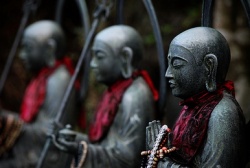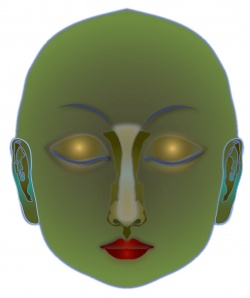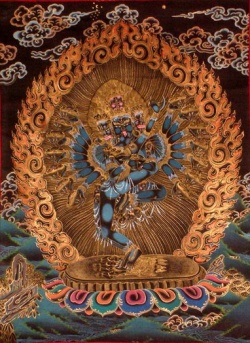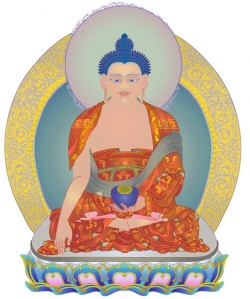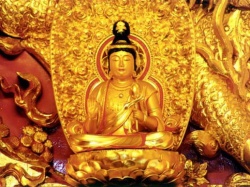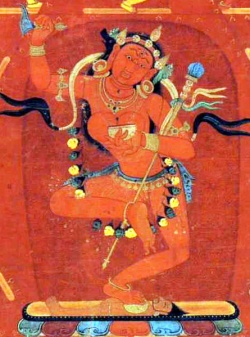Trikaya
The Trikaya Doctrine (Sanskrit, literally "Three bodies or personalities"; 三身 Chinese language Chinese: Sānshén, Japanese Language Japanese: sanjin) is an important Buddhist teaching both on the nature of reality, and what a Buddha is.
By the 4th century Common Era CE the Trikaya Doctrine had assumed the Form that we now know. Briefly the Doctrine says that a Buddha has three 'bodies': the nirmanakaya or
created Body which manifests in time and space;
the sambhogakaya or Body of mutual enjoyment which is an archetypal manifestation; and
the Dharmakaya or 'Reality Body' which 'embodies' the very principle of Enlightenment.
Trikaya
Later Mahayana Buddhists were concerned with the transcendent aspect of the Dharma.
So therefore if the Dharma is transcendental, totally beyond space and time, then so is the Dharmakaya.
One response to this was the development of the Tathagatagarbha Doctrine.
Another was the introduction of the Sambhogakaya which conceptually fits between the rupakaya, now renamed nirmanakaya or created Body, and the Dharmakaya.
The Sambhogakaya is that aspect of The Buddha, or the Dharma, that one meets in visions and in deep Meditation.
It could be considered an interface with the Dharmakaya.
What it does, and what the Tathagatagarbha Doctrine also does, is bring the transcendental within reach, it makes it immanent.
Definition
The Doctrine says that a Buddha has three kāyas or bodies:
- The Dharmakaya or Truth Body which embodies the very principle of enlightenment and knows no limits or boundaries;
- The Sambhogakāya or Body of mutual enjoyment which is a Body of bliss or clear Light manifestation;
- The Nirmāṇakāya or created Body which manifests in time and space.
Origins
Buddhism has always recognised more than one Buddha.
In the Pali Canon twenty-eight previous Buddhas are mentioned, and Gautama Buddha, the historical Buddha, is simply the Buddha who has appeared in our world age.
Even before the Buddha's parinirvana the term Dharmakaya was current. Dharmakaya literally means Truth Body, or Reality Body.
However all of these Buddha are unified in two ways: firstly they share similar special characteristics.
All Buddhas have the 32 major marks, and the 80 minor marks of a superior being.
These marks are not necessarily physical, but are talked about as bodily features.
They include the 'ushinisha' or a bump on the top of the head; hair tightly curled; a white tuft of hair between the eyes, long arms that reach to their knees, long fingers and toes that are webbed; his penis is completely covered by his foreskin;
images of an eight-spoked wheel on the soles of their feet etc.
Clearly if these were physical marks the Buddha would have been a strange looking individual.
But since not everyone was able to discern these marks on him, we can assume that they were either metaphorical, or a psychic phenomenon.
The other thing that all Buddhas have in common, is the Dharma that they teach, which is identical in each case.
In the Pali Canon The Buddha tells Vasettha that the Tathagata (the Buddha) was Dharmakaya, the 'Truth-Body' or the 'Embodiment of Truth', as well as Dharmabhuta, 'Truth-become', that is, 'One who has become truth' (Digha Nikaya).
On another occasion, The Buddha told Vakkali:'He who sees the Dhamma (Truth) sees the Tathagata, he who sees the Tathagata sees the Dhamma (Samyutta Nikaya).
That is to say, the Buddha is equal to truth, and all Buddhas are one and the same, being no different from one another in the Dharmakaya, because truth is one.'
After the Buddha's parinirvana a distinction was made between the Buddhas physical body, rupakaya; and his Dharmakaya aspect.
This was an understandable and necessary development.
As the Buddha told Vakkali, he was a living example of the 'Truth' of the Dharma.
Without that form to relate to, the Buddha's followers could only relate to the Dharmakaya aspect of him.
Despite the growth of the stupa cult in which the remains,
or relics, of enlightened beings were worshipped, Buddhism sees such things as symbols of the truth, rather than the truth itself.
Pali Canon
Even before the Buddha's parinirvāṇa the term Dharmakaya was current. Dharmakāya literally means Truth Body, or Reality Body.
In the Pali Canon the Buddha tells Vasettha that the Tathāgata (the Buddha) was Dharmakaya, the 'Truth-Body' or the 'Embodiment of Truth', as well as Dharmabhuta, 'Truth-become', 'One who has become Truth'
The Buddha is equated with the Dhamma:
... and The Buddha comforts him, "Enough, Vakkali. Why do you want to see this filthy body? Whoever sees the Dhamma sees me; whoever sees me sees the Dhamma."
Putikaya, the "decomposing" body, is distinguished from the eternal Dhamma Body of the Buddha and the Bodhisattva Body.
Mahāyāna
The Dharmakāya-doctrine was possibly first expounded in the Aṣṭasāhasrikā prajñā-pāramitā (The Perfection of Insight In Eight Thousand Verses), composed in the 1st century BCE.
Mahayan Buddhism introduced the Sambhogakāya, which conceptually fits between the Nirmāṇakāya and the Dharmakaya.
The Sambhogakaya is that aspect of the Buddha, or the Dharma, that one meets in visions and in deep meditation. It could be considered an interface with the Dharmakaya.
The Trikaya-Doctrine and the Tathagatagarbha bring the transcendental within reach, by placing the transcendental within the plane of immanence.
Around 300 CE, the Yogacara school systematized the prevalent ideas on the nature of the Buddha in the Trikaya or three-body doctrine.
Interpretation in Buddhist traditions
Schools have different ideas about what the three bodies are.
Chinese Mahayana
Pure land
The Three Bodies of the Buddha from the point of view of Pure land Buddhist thought can be broken down like so:
- The Nirmaṇakāya is a physical body of a Buddha.
An example would be Gautama Buddha's body.
- The Sambhogakāya is the reward-body, whereby a Bodhisattva completes his vows and becomes a Buddha.
Amitābha, Vajrasattva and Manjushri are examples of Buddhas with the Sambhogakaya Body.
- The Dharmakaya is the embodiment of the truth itself, and it is commonly seen as transcending the forms of physical and spiritual bodies.
Vairocana Buddha is often depicted as the incomprehensible Dharmakāya, particularly in Esoteric Buddhist schools such as Shingon and Kegon in Japan.
As with earlier Buddhist thought, all three forms of the Buddha teach the same Dharma, but take on different forms to expound the truth.
Chán
According to the Lin-ji yu-lu ("Zen teachings of Rinzai") the Three Bodies of the Buddha are not to be taken as absolute.
They are "mental configurations" that "are merely names or props" and only the play of light and shadow of the mind.
The Lin-ji yu-lu states it this way:
Do you wish to be not different from the Buddhas and patriarchs? Then just do not look for anything outside.
the Pure Light of your own heart [i.e., 心, mind at this instant is the Dharmakaya Buddha in your own house.
The non-differentiating Light of your heart at this instant is the Sambhogakaya Buddha in your own house.
The non-discriminating light of your own heart at this instant is the Nirmanakaya Buddha in your own house.
This trinity of the Buddha's body is none other than he here before your eyes, listening to my expounding the Dharma.
Tibetan Buddhism
Fourth Body - Svabhavikakaya
Vajrayana sometimes refers to a fourth body, called the Svabhavikakaya (Tibetan:ངོ་བོ་ཉིད་ཀྱི་སྐུ, Wylie: ngo bo nyid kyi sku, THDL: ngo wo nyi kyi ku), meaning essential body.
In the book Embodiment of Buddhahood Chapter 4 the subject is:
Embodiment of Buddhahood in its Own Realization: Yogacara Svabhavikakaya as Projection of Praxis and Gnoseology.
The Svabhavikakaya is simply the unity or non-separateness of the Three Kayas.
The term Svabhavikakaya is also known in Gelug teaching, where it is one of the assumed two aspects of Dharmakaya:
Essence body/Svabhavikakaya and wisdom body or body of Gnosis/Jnanakaya.
Haribhadra (Seng-ge Bzang-po) claims, that Abhisamayalankara chapter 8 is describing Buddhahood through four kayas:
Dzogchen
In Dzogchen teachings, "Dharmakaya" means the Buddha-nature's absence of self-nature,
that is, its emptiness of a conceptualizable essence, its cognizance or clarity is the sambhogakaya, and the fact that its capacity is 'suffused with self-existing awareness' is the nirmanakaya.
Mahamudra
The interpretation in Mahamudra is similar: when the mahamudra practices come to fruition,
one sees that the mind and all phenomena are fundamentally empty of any identity;
this emptiness is called dharmakāya.
The essence of mind is seen as empty, yet having potential which takes the form of luminosity;
the nature of the sambhogakāya is understood to be this luminosity.
The nirmanakāya is understood to be the powerful force with which the potentiality effects living beings.
Anuyoga
In the view of Anuyoga, the 'mindstream' (Sanskrit: Citta santana) is the 'continuity' (Sanskrit: santana; Wylie: rgyud) that links the Trikaya.
The Trikāya, as a triune, is symbolised by the Gankyil.
Dakinis
A Dakini (Sanskrit: डाकिनी ḍākinī; Standard Tibetan: མཁའ་འགྲོ་མ་ khandroma, Wylie: mkha' 'gro ma, TP: kanzhoima;
Chinese: 空行母) khandroma, Wylie: mkha' 'gro ma, Tibetan Pinyin: kanzhoima; Chinese:
空行母) is a tantric deity described as a female embodiment of enlightened energy.
In the Tibetan language, dakini is rendered khandroma which means 'she who traverses the sky' or 'she who moves in space'. Sometimes the term is translated poetically as 'sky dancer' or 'sky walker'.
Dakinis can also be classified according to the Trikaya, or three bodies of a Buddha.
The dharmakāya dakini, which is Samantabhadrī, represents the Dharmadhatu where all Phenomena appear.
The Sambhogakāya dakinis are the yidams used as meditational deities for tantric practice.
The nirmanakaya dakinis are human women born with special potentialities, these are realized yogini,
the consorts of the gurus, or even all women in general as they may be classified into the five Buddha-families.
Western Buddhism
Theosophy
In the 19th century Theosophy took an interest in Buddhism.
It regarded Buddhism to contain esoteric teachings.
In those supposed esoteric teachings of Buddhism, "exoteric Buddhism" believes that Nirmanakaya simple means the {physical body of Buddha.
According to the esoteric interpretation, when the Buddha dies he assumes the Nirmanakaya, instead of going into nirvana.
He remains in that glorious body he has woven for himself, invisible to uninitiated mankind, to watch over and protect it.
